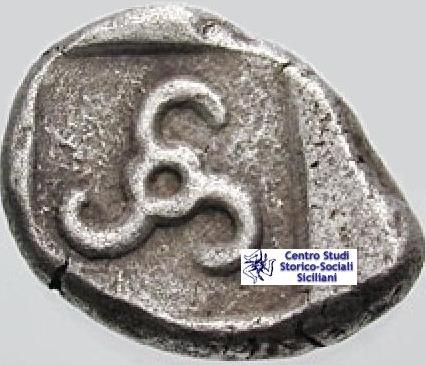
Alla ricerca dello stemma dimenticato

In search of the forgotten coat of arms
The Trinacria is a symbol for the millenia - one which
has taken root and has become a passionate Sicilian tradition. It derives
from the archaic Triskele, that is that strange figure composed of a head
of woman from which three human legs are folded at the knee - of Sicily,
the notion of the geographic triangular shape of the island finds one of
symbolic depiction of the monster with three legs, tr quetra (to three
apexes or triangular). In fact, its particular geographic configuration,
characterized from three capes, Pachino, Peloro and Lilibeo, are very well
adapted to that figure to which the Romans imposed the same overall name
for the Island. Perhaps from this configuration to the three apexes, the
name Triquetra or Trinacria was given in the Hellenistic Age. That strange
and characteristic representation at the same time, was of the Gorgon-like
figure of three legs, and was even adopted in some coins of classic
antiquity, and become the official symbol of the island. Philology
supports that this last denomination is improper, while it is contended
more that in Greek the Trisk les, is translatable into " three legs ".
Students agree in asserting that the draft of an ancient
religious oriental symbol is that which is the God Baal or the sun is
representing the God Baal, in its triple shape of the Gods of Spring,
Summer and Winter, and the representation of the moon with the legs
sometimes replacing the lunar scythes. Its more ancient documentary
manifestations are found in coins of several cities of Asia Minor, such as
Aspendo in Panfilia, Olba in Cilicia, Berrito and Tebe in the Troade, and
variable cities of Lycea, dating from the VI to the IV century B.C.
The Trinacria symbol, if losing its original solar value,
nevertheless acquired a sacred status in Sicily as it transformed itself
into a talisman. In its essentially divine geographic value, it was so
identified with Sicily in its various denominations of Trinacria,
Triscele, Triquetra and Trichetria. The symbol of the Trinacria is found
in the Island of Man in the sea of Ireland, and accordingly carried a
local legend from the Normans who came into Sicily in the X - XI
centuries. The Normans replaced the ancient symbol of the Irish island
which was then under a Scandinavian king with the Trinacria. It flew from
their boats and vessels. The Sicilian symbol is found in coats of arms of
foreign noble families, such as the English Stuart of Albany (probably in
order to indicate their dominion of the islands of the Irish sea, such as
the Island of Man), the Drocomir of Polonia, the Rabensteiner of
Franconia, the Schanke of Denmark, as well as those also in more recent
times. King Gioacchino Murat incorporated the Trinacria in his
coat-of-arms, holding account that this same figure was most diffuse in
the antiquity in other countries, such as: Lycea, Panfilia, Pisidia, Clay,
Rodi, Macedonia, Thrace, Celtic Iberian Spain, and Celtic countries such
as the Island of Man, etc. - to which, if they did not tie a geographic
connection - what is therefore, its true meaning or its original one?

The HYPOTHESES Of GREEK ORIGIN
The HYPOTHESES Of MINOAN ORIGIN

Finally, as regards the official flag of the Sicilian Region, it is made from a bicolored yellow rose drapery with the old triscelic symbol of the Trinacria in the center , then diagonally it expresses the yellow of the civic flag of Palermo and red of the civic flag of Corleone, which was the first common Sicilian flag to follow the example of Palermo at the time of the vigorous anti-French uprising of the Sicialian Vespers in the important City of Palermo, 30 March 1282.


- THE CENTER FOR HISTORICAL SICILIAN SOCIAL STUDIES, CATANIA -

e-mail: info@cssss.org
| Sostienici con la tua iscrizione. Diventa Socio del CSSSS |


Tutti i diritti sono riservati-Copyright 1996-2025
© Centro Studi Storico-Sociali Siciliani Catania
Realizzazione CEM 21/02/1996
© Centro Studi Storico-Sociali Siciliani Catania
Tutto il materiale presente in questa pagina è riservato. L'uso, l'utilizzo e il transfert sono soggetti ad autorizzazione.






























